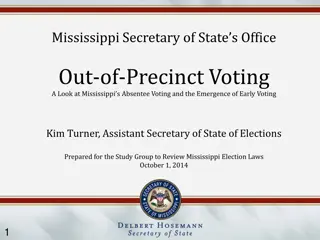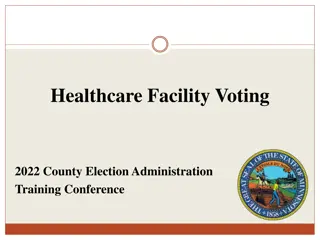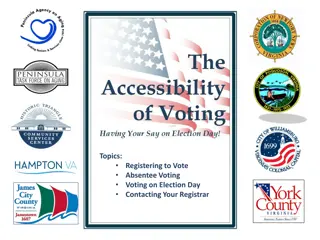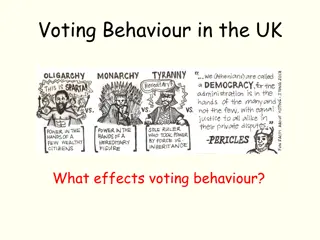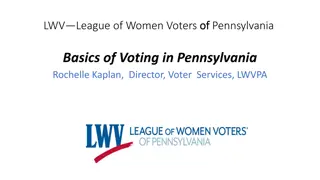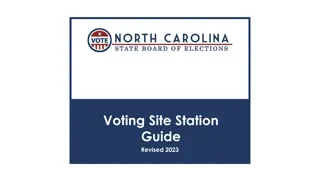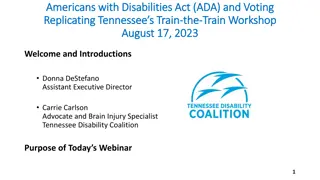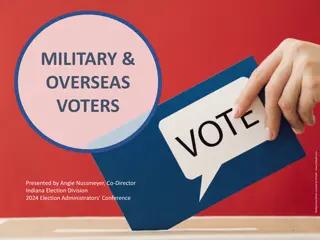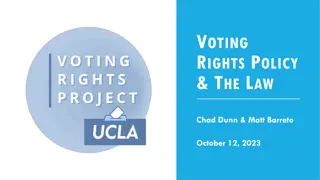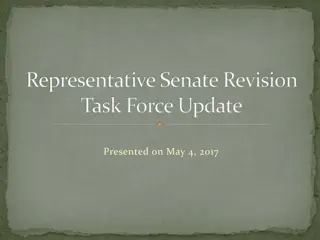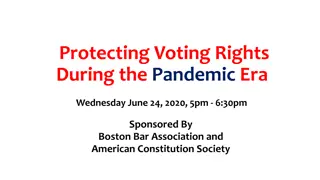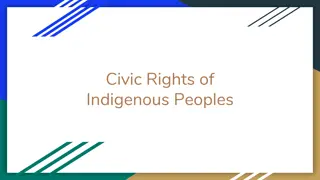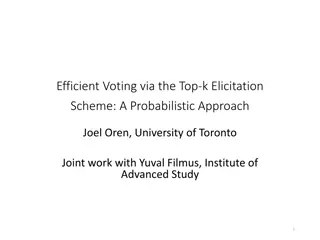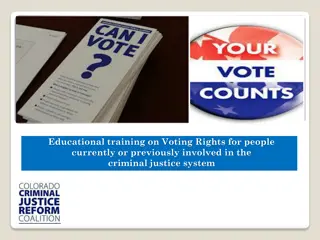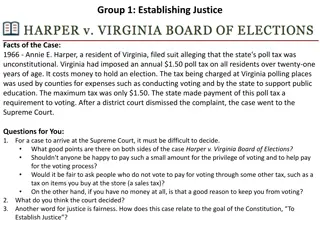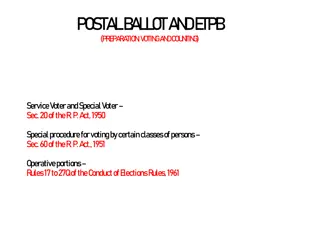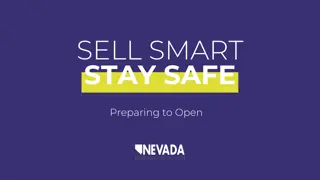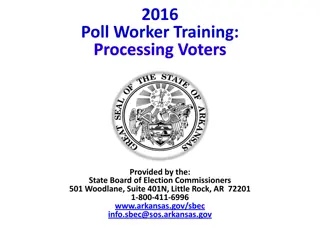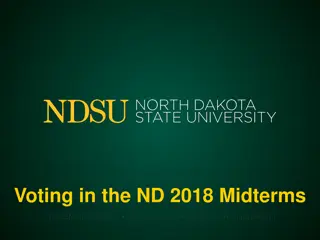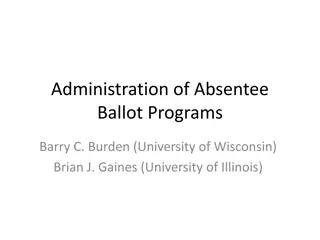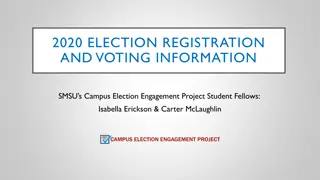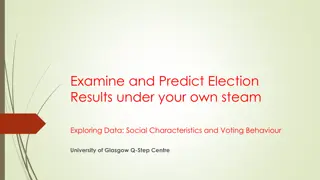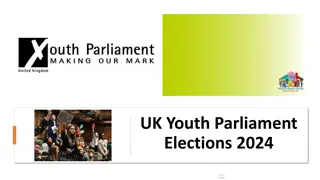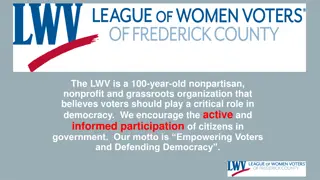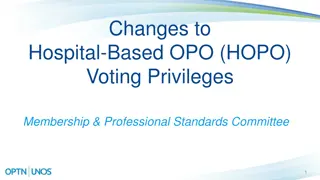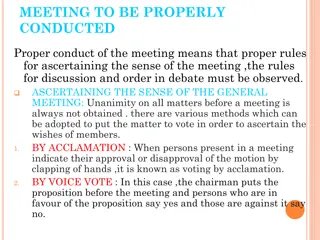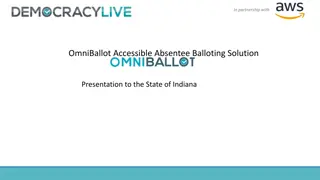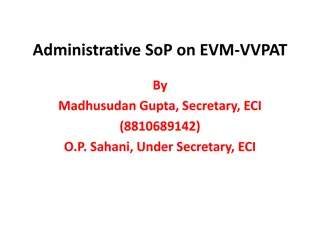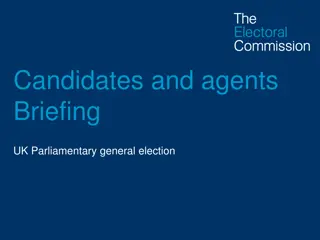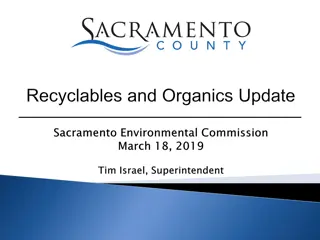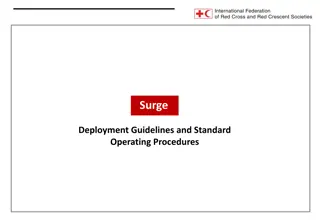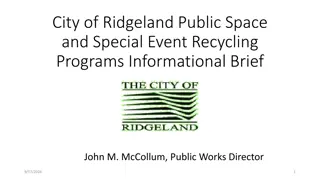Curbside Voting Procedures and Guidelines 2023
Detailed guide on curbside voting procedures including voter greeting, ID verification, assistance eligibility, and ballot authorization. Explains steps for curbside officials to ensure smooth voting process for individuals requiring assistance or voting from vehicles.
Download Presentation

Please find below an Image/Link to download the presentation.
The content on the website is provided AS IS for your information and personal use only. It may not be sold, licensed, or shared on other websites without obtaining consent from the author. Download presentation by click this link. If you encounter any issues during the download, it is possible that the publisher has removed the file from their server.
E N D
Presentation Transcript
Curbside Voting Site Station Guide Revised 2023
Curbside Procedures 1 Voter Greeting 2 Initial Photo ID Review 3 Examination of Photo and Name on Photo ID 4 Voter Status Review 5 Address Review 6 Party Affiliation Review Curbside Steps
Curbside Procedures Generate Vote Authorization Documents 7 8 Assemble Balloting Materials Obtain Voter Signatures 9 Allow Voter to Mark Ballot 10 11 Accept Voter s Ballot Curbside Steps
Step 1: Voter Greeting Ask the name of the person voting curbside Determine if the voter requires assistance Read oath to the voter and receive affirmation to confirm curbside eligibility Complete a curbside log Ask the voter to show a photo ID
Ask the name of the person voting curbside When approaching the curbside voting area, the curbside official must first determine who desires to vote from the vehicle. This can be accomplished by asking for the name of the person who is voting curbside. If a person is unable to state their name because of an impairment, the curbside official may make reasonable accommodations, including asking the voter to write their name. The voter may be able but unwilling to state their name. The curbside official will explain that the law requires voters to state their name aloud. If the voter continues to refuse to cooperate with the curbside official, the official will arrange for the voter to speak with an election judge. Step 1: Voter Greeting Curbside | 1
Determine if the voter requires assistance If a voter is in need of assistance, it must be requested. If a voter is accompanied when presenting to vote, a curbside official must determine if the voter wants assistance from someone in the vehicle. The voter may also ask for assistance from an election official. Who may assist a voter? A voter is entitled to assistance from a near relative: spouse, parent, child, brother, sister, grandparent, grandchild, stepparent, stepchild, mother-in-law, father-in-law, son-in-law, daughter-in-law Who may receive voter assistance? Disabled voters may receive the following forms of assistance from anyone except an agent of their employer or union representative: Help entering the voting booth due to physical disability or blindness Assistance in marking the ballot due to physical disability, illiteracy, or blindness Curbside| 2 Step 1: Voter Greeting
Election officials should follow the script below to determine if a voter is entitled to assistance: 1. Ask the voter: Is this person here to assist you? a. If YES, go to question 2. b. If NO, instruct the person that they need to wait outside the voting enclosure. 2. Ask the voter: Is this person a near relative? Refer to explanation of who can assist a voter. a. If YES, the voter may receive assistance. No further information is needed. b. If NO, go to question 3. 3. Say: A voter who needs assistance because the voter is blind, disabled, or unable to read, speak, or write English may receive assistance from a person of the voter s choice. Do you need assistance for one of these reasons? a. If YES, go to #4. b. If NO, the voter is not entitled to receive assistance from someone who is not a near relative. If requested by the voter, an assistant, judge, or chief judge may assist the voter. 4. Ask the voter: Is this person your employer, your employer s agent, an officer of your union, or an agent of your union? entering the voting booth due to physical disability or blindness, assistance in marking the ballot due to physical disability, illiteracy, or blindness a. If YES, the person may not assist the voter. The voter may select someone else to assist him or her. If requested by the voter, an assistant, judge, or chief judge may assist the voter. b. If NO, the voter may receive assistance. No further information is needed. Step 1: Voter Greeting Curbside |3
Read oath to the voter and receive affirmation to confirm curbside eligibility The curbside official can determine eligibility by giving the voter the curbside oath and receiving a response that the voter will be able to sign the curbside affidavit. Do you solemnly swear (or affirm): that you are a registered voter in this_________ precinct? that because of age or physical disability you are unable to enter the voting place to vote in person without physical assistance? that you desire to vote outside the voting place and enclosure? and you understand that a false statement as to your condition will be in violation of North Carolina law? If the voter swears or affirms, continue with the curbside check-in procedures. If the voter cannot swear or affirm to the curbside oath, the voter must be instructed to vote inside the voting enclosure. disability or blindness, assistance in marking the ballot due to physical disability, illiteracy, or blindness Step 1: Voter Greeting Curbside |3
Step 1: Voter Greeting Request the Voter s Photo ID (you do not need to take the photo ID into the voting enclosure) NC law requires a voter to show an acceptable form of photo ID or to sign a form claiming an exception (the Photo ID Exception Form). If a voter says they forgot their ID, ask them if they can easily retrieve it. If they cannot, they must be informed of the options for voting a provisional ballot without an ID. The following circumstances require the curbside official to inform the voter of the options for voting a provisional ballot without an ID: If a voter does not show photo ID due to some difficulty that prevents the voter from presenting a photo ID (a reasonable impediment ) If a voter simply refuses to show a photo ID If a voter does not show photo ID due to a religious objection to being photographed If a voter does not show photo ID because they are a victim of a recent natural disaster If a voter needs to cast a provisional ballot, please follow the procedures in step 7 and 8. Step 1: Voter Greeting Curbside |3
Request the Voters Photo ID (you do not need to take the photo ID into the voting enclosure) The curbside election official should use the list of Acceptable Photo IDs for Voting in 2023 and the Common ID Flyer to confirm that the photo ID presented is an acceptable type of ID.
Step 2: Initial ID Review Inspect the photo ID Determine if the photo ID is an acceptable type Determine if the photo ID meets expiration requirements Determine if the photograph on the photo ID reasonably resembles the person presenting to vote
Step 3: Evaluation of the Name on the Photo ID Return ID to voter and proceed to check in station Determine if the name on the photo ID is the same as or substantially equivalent to the name on the voter record (Electronic or Paper List) Make a final determination that the photo ID meets all requirements
After Making a Final Determination on the Photo ID If the curbside election official determines that the photo ID meets all requirements, then proceed to the next step. If the official finds that the photograph on the photo ID does not bear a reasonable resemblance to the person presenting to vote or that the name on the ID is not the same as or substantially equivalent to the name on the voter record, then the official must inform the voter of the reasons the election official made the determination and invite the person to provide any other acceptable photo ID that they may have. If the voter does not offer another type of acceptable photo ID, the curbside official must enter a challenge immediately notify the judges of election by using the help referral form. The judges will conduct the challenge hearing at the curbside voting location, and the judges may separately visit the curbside location to review the evidence. Step 3: Evaluation of the Photo and Name on the Photo ID Curbside |
Step 4: Voter Status Review Determine the voter s registration status Determine whether there are voter status issues that need to be resolved before a ballot can be issued
Step 5: Address Review Remember, the address on a voter s photo ID for is not required to match the address on the voter s record. Compare address provided on the curbside log with address on voter record
Step 6: Party Affiliation Review This step is for partisan primaries only Compare party information provided on the curbside log with party on voter record
Step 7: Generate Vote Authorization Documents If the voter is registered and qualified to vote: obtain their vote authorization document from Check-in If the voter cannot be issued a regular ballot: obtain a provisional voting application from the Help Station
Step 8: Assemble Balloting Materials Regular Ballot ATV or one-stop application Privacy sleeve Ballot Provisional Ballot Provisional Voting Application Privacy sleeve Ballot Provisional envelope Photo ID Exception Form (if applicable) Provisional voter instructions
Step 9: Obtain Voter Signatures Review the document(s) with the voter to ensure the information on the form(s) is correct Indicate areas on the relevant form(s) that require the voter s signature Allow the voter to sign the document(s) Collect the document(s)
Step 10: Allow Voter to Mark Ballot Provide the voter with the balloting materials and voting instructions Provide voter with instructions on how to indicate they have completed voting Monitor curbside area to ensure vehicle is not approached by electioneers
Step 11: Accept Voters Ballot If regular ballot: deliver ballot in privacy sleeve to a judge of election to cast ballot and deliver the signed vote authorization document(s) to the Ballot Station If provisional ballot: deliver ballot sealed in the provisional envelope along with form(s) to the Help Station Official




